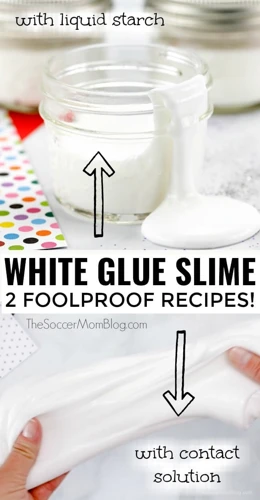The world of do-it-yourself projects opens up a realm of creativity and customization, and making your own DIY white glue is no exception. This handy substance is a staple in both household tasks and craft endeavors, and learning how to make glue on your own can be both fulfilling and practical. This blog post will guide you through the process, ensuring that you can create a reliable adhesive with ease.
Benefits of Homemade Glue
Non-Toxic Glue Making
One significant advantage of creating your own homemade glue recipe is the ability to control the substances you’re exposed to. Commercial glues often contain chemicals that can be harmful if ingested or inhaled, especially by children. Non-toxic glue making is not only safer but also better for the environment, reducing your carbon footprint by avoiding products with harsh chemicals.
Natural Adhesive for Safe Crafting
Crafting should be a fun and safe activity for everyone involved. Using a natural adhesive ensures that your art projects are eco-friendly and safe for all ages. When making white glue at home, you can trust that the materials you’re using are gentle enough for any crafting project, adding an extra layer of safety to your creative work.
White Glue Ingredients and Supplies
Essential Ingredients for White Glue
- Water
- White vinegar
- Plain flour or cornstarch
- Sugar
Tools and Equipment Needed
- Measuring cups and spoons
- Medium-sized saucepan
- Whisk or spoon for stirring
- Heat source (stove or hot plate)
- Airtight container for storage
Step-by-Step Homemade Glue Recipe
Preparing Your Ingredients
Begin your glue-making journey by accurately measuring all white glue ingredients. It’s crucial to get the proportions right to ensure the final product’s effectiveness. Gather your tools and ensure that you have a clean workspace to start your homemade adventure.
Mixing and Cooking the Glue
With everything in place, combine the ingredients in your saucepan over a moderate heat source. Stirring continuously is key to avoiding lumps and achieving a smooth consistency. As the mixture thickens, you’re on your way to creating a strong bond for your projects.
Cooling and Storing Your Glue
Once the mixture has reached the desired thickness, remove it from the heat and let it cool. After it has settled to room temperature, transfer the DIY white glue into an airtight container for preservation. Proper storage is essential to maintain the shelf life of your homemade concoction.
Easy Glue Recipes for Various Uses
Basic Craft Glue Recipe
For general crafting needs, a basic craft glue recipe might be all you require. This simple concoction is perfect for paper projects and lightweight materials, offering a dependable stickiness with minimal fuss.
No-Cook Natural Glue Recipe
If you’re in a pinch or prefer not to use heat, a no-cook natural glue recipe can come to the rescue. This version can be quickly mixed and used immediately for emergency repairs or impromptu art sessions.
Customizing Your White Glue
Adjusting Consistency and Stickiness
Not all projects are created equal, and sometimes you need a glue that’s a little thicker or thinner. Adjusting the consistency and stickiness of your homemade glue is simple, allowing you to tailor it to the task at hand.
Additives for Enhanced Durability
For projects that demand more resilience, consider adding natural preservatives or strengthening agents to your glue. These additives can help enhance the durability of your adhesive, ensuring that it holds up under tougher conditions.
Practical Applications: White Glue Uses
Everyday Home and School Projects
The beauty of white glue uses lies in its versatility. It’s perfect for everything from home repairs to school projects, proving itself as an indispensable tool in your DIY arsenal.
Specialty Crafts and Repairs
For those specialty crafts and repairs that require a delicate touch, your homemade white glue can be modified to suit the needs of intricate designs and fragile materials, proving its worth as a multifaceted adhesive solution.
Tips for Successful Glue Making at Home
To ensure your glue-making endeavor is a success, pay close attention to measurements, stir frequently to avoid clumping, and store your glue properly. With these tips in mind, your homemade glue will be ready for action whenever you need it.
FAQs: Common Questions About Making White Glue
This section will address common inquiries about the glue-making process, providing you with additional insights and information to enhance your DIY experience.
Conclusion: Crafting with Your DIY White Glue
Crafting with your DIY white glue can be both an enjoyable and eco-conscious decision. With the right recipe and a little practice, you’ll find that your homemade adhesive is not only effective but also a healthier choice for both you and the planet.
If you’re interested in creating your own adhesives for various projects, you’ve come to the right place! While you’re discovering how to make white glue, you might also be curious about other types of homemade glues. For more specialized applications, check out our guides on how to make black glue, perfect for crafting and repair work where a darker adhesive is needed. If you’re working with pottery or sculptures, our tutorial on how to make clay glue can be incredibly helpful. And for paper crafts, be sure to read our article on how to make paper glue to create the perfect bond for your paper projects. All these guides are designed to help you make the right glue for your creative needs!
References and Further Reading
For those interested in delving deeper into the world of adhesives and crafting, a list of references and suggested reading materials will offer a wealth of knowledge on the subject.

